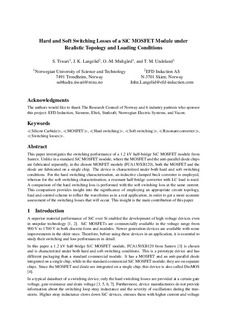| dc.contributor.author | Tiwari, Subhadra | |
| dc.contributor.author | Langelid, John Kåre | |
| dc.contributor.author | Midtgård, Ole-Morten | |
| dc.contributor.author | Undeland, Tore Marvin | |
| dc.date.accessioned | 2018-02-16T14:32:39Z | |
| dc.date.available | 2018-02-16T14:32:39Z | |
| dc.date.created | 2017-11-15T19:01:57Z | |
| dc.date.issued | 2017 | |
| dc.identifier.isbn | 978-90-75815-27-6 | |
| dc.identifier.uri | http://hdl.handle.net/11250/2485464 | |
| dc.description.abstract | This paper investigates the switching performance of a 1.2 kV half-bridge SiC MOSFET module from Sanrex. Unlike in a standard SiC MOSFET module, where the MOSFET and the anti-parallel diode chips are fabricated separately, in the chosen MOSFET module (FCA150XB120), both the MOSFET and the diode are fabricated on a single chip. The device is characterized under both hard and soft switching conditions. For the hard switching characterization, an inductive clamped buck converter is employed, whereas for the soft switching characterization, a resonant half-bridge converter with LC load is used. A comparison of the hard switching loss is performed with the soft switching loss at the same current. This comparison provides insight into the significance of employing an appropriate circuit topology, load and control scheme to reflect the waveforms as in a real application, in order to get a more accurate assessment of the switching losses that will occur. This insight is the main contribution of this paper. | nb_NO |
| dc.language.iso | eng | nb_NO |
| dc.publisher | Institute of Electrical and Electronics Engineers (IEEE) | nb_NO |
| dc.relation.ispartof | 19th European Conference on Power Electronics and Applications (EPE'17 ECCE Europe), 2017 | |
| dc.title | Hard and soft switching losses of a SiC MOSFET module under realistic topology and loading conditions | nb_NO |
| dc.type | Chapter | nb_NO |
| dc.description.version | submittedVersion | nb_NO |
| dc.source.pagenumber | 1-10 | nb_NO |
| dc.identifier.doi | 10.23919/EPE17ECCEEurope.2017.8099140 | |
| dc.identifier.cristin | 1514605 | |
| dc.description.localcode | © 2017 IEEE. Personal use of this material is permitted. Permission from IEEE must be obtained for all other uses, in any current or future media, including reprinting/republishing this material for advertising or promotional purposes, creating new collective works, for resale or redistribution to servers or lists, or reuse of any copyrighted component of this work in other works. | nb_NO |
| cristin.unitcode | 194,63,20,0 | |
| cristin.unitname | Institutt for elkraftteknikk | |
| cristin.ispublished | true | |
| cristin.fulltext | preprint | |
| cristin.qualitycode | 1 | |
